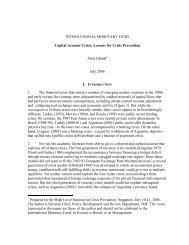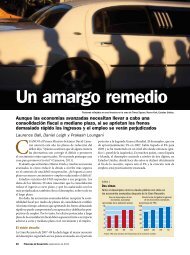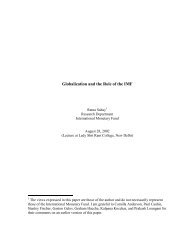Chapter 20: Taxation of Corporate Reorganizations - IMF
Chapter 20: Taxation of Corporate Reorganizations - IMF
Chapter 20: Taxation of Corporate Reorganizations - IMF
Create successful ePaper yourself
Turn your PDF publications into a flip-book with our unique Google optimized e-Paper software.
Tax Law Design and Drafting (volume 2; International Monetary Fund: 1998; Victor Thuronyi, ed.)<br />
<strong>Chapter</strong> <strong>20</strong>, <strong>Taxation</strong> <strong>of</strong> <strong>Corporate</strong> <strong>Reorganizations</strong><br />
In corporate divisions, one way to solve the problem is to make all transferee companies<br />
jointly liable for tax obligations, which means that they can also act jointly in tax protests and tax<br />
litigation after a corporate division. In practice, collection <strong>of</strong> tax liabilities should always follow<br />
the business activity <strong>of</strong> the transferee companies. The other transferee companies should be<br />
liable only when the tax liability cannot be collected from the transferee company to which it<br />
belongs. If a tax liability is specifically linked to a particular asset (e.g., land tax on real estate),<br />
the tax liability and ensuing tax protests and tax procedures may appropriately follow the asset.<br />
V. Taxes Other Than Income Tax<br />
The tax consequences <strong>of</strong> corporate reorganizations are not limited to income tax. There<br />
are always the problems <strong>of</strong> carrying over the tax characteristics <strong>of</strong> any tax from transferor to<br />
transferee company and from old to new shares. For two types <strong>of</strong> taxes, the problems are more<br />
pressing than for others because they raise problems <strong>of</strong> tax exemption: taxes on capital<br />
contributions and value-added tax.<br />
Many countries levy taxes on equity contributions to capital or stamp duties on transfers<br />
<strong>of</strong> assets. 93 A corporate reorganization <strong>of</strong>ten requires a formal capital contribution, which in<br />
some cases may impose a considerable tax burden (e.g., if a newly formed subsidiary is<br />
involved). The reasons for exempting reorganizations from tax on capital contribution or stamp<br />
taxes are largely the same as the reasons for exemption from income tax. The basic difference<br />
between the exemption from these taxes and the exemption from income tax is that the former is<br />
final, whereas the latter is temporary. The simplest way to deal with this exemption is to impose<br />
the same conditions for exemption as in the income tax.<br />
Finally there is the problem <strong>of</strong> value-added tax or sales tax. 94 Here too, there is a case for<br />
temporary exemption, as long as the transferee who carries on the business also remains<br />
responsible for all tax obligations. It will not be appropriate, however, to impose the same<br />
conditions for exemption as in the income tax, for the simple reason that the tax fate <strong>of</strong> the<br />
shareholders <strong>of</strong> the transferor company is irrelevant to the sales tax or value-added tax. Only the<br />
transferor and the transferee company are involved as taxpayers. Therefore, the only<br />
requirements that should be imposed are (1) that the business activity should be transferred to<br />
and continued by the transferee (transfer <strong>of</strong> all or substantially all assets and liabilities), 95 and (2)<br />
that the transferee should be subject to sales tax or value-added tax with the same rights and<br />
obligations as the transferor. The type <strong>of</strong> consideration paid in the reorganization is irrelevant<br />
(therefore, sales <strong>of</strong> a business should qualify for exemption). The type <strong>of</strong> taxpayer is also<br />
irrelevant, so that it should be possible to have a transfer free <strong>of</strong> value-added tax between a<br />
corporation and an individual and vice versa as long as both parties are taxpayers under the<br />
value-added tax. The same approach can be applied in the case <strong>of</strong> the excise tax.<br />
93 Exemptions from these taxes in reorganizations are discussed in Tomsett et al., supra note 45.<br />
94 See vol. 1, at 216–17.<br />
95 In contrast to the requirements for tax-free reorganizations under the income tax, here, substantially all the assets<br />
means the assets <strong>of</strong> a business, not all the assets <strong>of</strong> the transferor (which may have several businesses).<br />
- 28 -
















